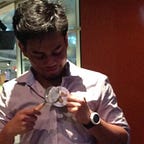An Old Town (but no coffee :/)
This weekend I had the opportunity to visit my Dad’s hometown, Taiping. Famous for its scenic lake garden and its amiability towards ageing population, the town itself is steep in history.
On Sunday’s morning, I attempted to walk around the morning and found out there are heritage trails, with signboard explaining each building’s significance. So I walked a few as permissible under broad sunlight, with no phone, and one-hour to kill.
I started with the Peking Hotel, then walked along the shop lots to Masjid Melayu Taiping. To my surprise, the late Dr. Burhanuddin al Helmy, one of the key figures of Kaum Muda who fought the British for independence with such vigor that many conformists couldn’t stand, and the third President of Parti Islam Se-Malaysia (PAS), was lain here in the mosque’s cemetery. The first burial in the cemetery is actually a woman, Toh Puan Halimah Binti Laksamana Muhammad Amin. She was buried there, just to years after the mosque was built in 1897. Too bad I couldn’t find her grave there, but I found a blogpost of who did.
Along those road, was a Hindu temple, then a Buddhist Temple, of which a wealthy man gifted his daughter for her interest in being a nun, then a Hokkien Society’s building, then right accross the street of the worship houses is the office of Orang Besar Jajahan.
While walking, I imagined the life in the late 19th and early 20th century when these buildings were founded. People of all races, coming, living and working together. Unlike in the US, where immigrants were forced by societal, legal and economic push to found their own “chinatown”, the many races of Malaya at that time were not. Even the so called Chinatown in the Petaling Street is not really “exclusively Chinese”. Amalgamation and cultural exchanges have been integral to Malaya’s identity, so why should Malaysians stop at the pre-independence racial mix? The flux of foreign workers and immigrants to Malaysia, who see Malaysia as their own land of opportunity, should only enrich Malaysia. Discrimination breeds contempt more than familiarity would.
Once we checked out, we drove around the Taman Tasik, War Cemetery signboard piqued my interest.
Then, we came back into town and I saw Amelia Earhart’s mural. Of course I had to inquire my Dad where is the actual land strip she landed, after the then-Resident of Malaya gave permission, which brought me here:
This trip rekindled my interest in southeast Asian in WWII — so probably I have to resume reading Forgotten Wars. The book is all dusty now. My bad. Taiping is really a town of heritages, but I would wish it is more pedestrian-friendly, i.e. more walk canopy and more information on the heritages.
p.s.: I don’t know about everyone else but I would hope that Sunday’s morning is bustling with people getting the coffee and breakfast but most of the shops were closed and even when I stop at Shell to get Costa, the machine’s broken.
